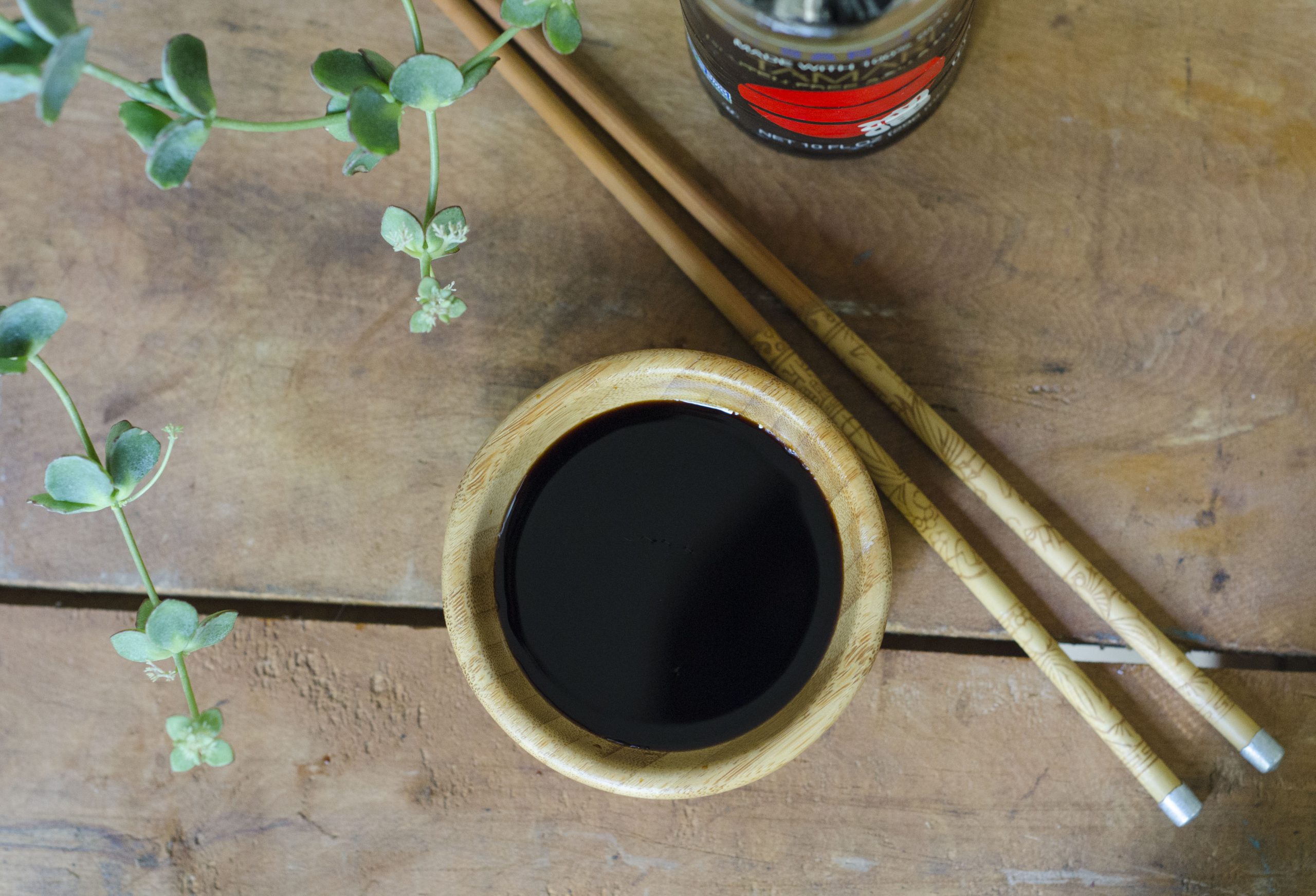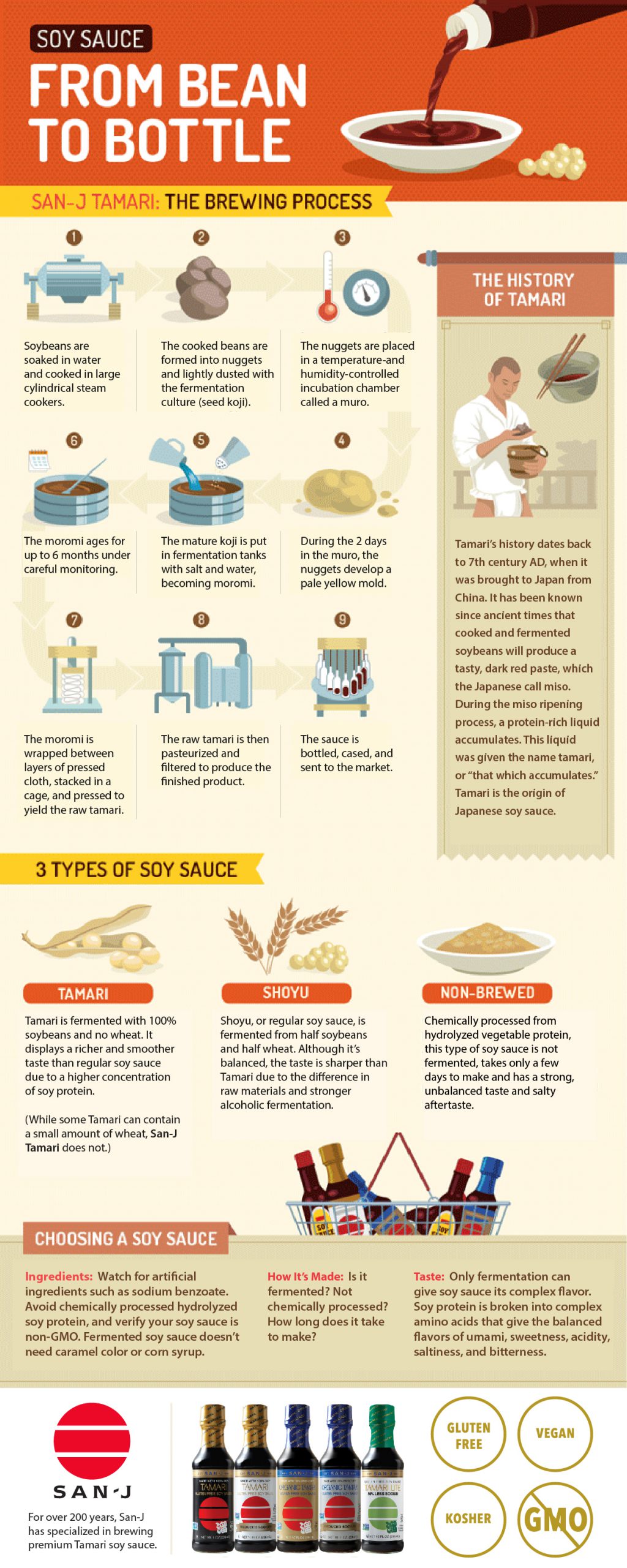Having been born and raised in Japan, soy sauce is something that was always on our family table. It was used in almost every dish and was a part of my life, just the like air you breathe. So I never paid attention to how soy sauce was made or how different varieties existed. To me, soy sauce was soy sauce.
It was when I first came to the United States and found SAN-J Tamari that I asked myself, “What is the difference between tamari and other soy sauces?” I was familiar with Tamari because I was from the region in Japan where Tamari was manufactured the most, but I had never thought about what it was exactly. The more I learned about soy sauce, the more fascinated I was.
History of Japanese Soy Sauce
The history of soy sauce goes back to ancient China. It was born from necessity when there was no refrigeration available. The Chinese used a method of food preservation where they pickled raw materials. The raw materials varied from meat, fish, vegetables, seaweed, grains and legumes, including soybeans. These fermented preserved foods became tasty seasonings called Jiang.
It is not clear when Jiang came to Japan, but Jiang, under the name “hishio” in Japanese first appeared in the Taiho Code, an administrative and penal code enacted in 701. It appeared that hishio was served at the dining table of palace banquets.
After that, it is said that the Japanese Zen monk brought the technique of miso (fermented soybean paste) making to Japan from China in the 13th century. While he was teaching villagers of Kishu Yuasa how to make miso, he noticed that the liquid that accumulated on the surface of miso paste was very tasty, and that became what is now known as “tamari soy sauce.”
Tamari soy sauce is the origin of Japanese soy sauce. In the 17th and 18th centuries, the manufacturing of soy sauce developed from a household art to a commercial industry, becoming an essential seasoning for Japanese cuisine.
I’ve always been intrigued by traditions that are hundreds or thousands of years old and still used by everyone today. That means what it was back then is still needed and still enriches people’s lives today. These traditions are usually made with natural materials because synthetic materials were not available back then. How amazing it is that nature is designed to fulfill our needs so perfectly and timelessly.
So, soy sauce is an incredible seasoning that has been passed down for thousands of years. Does that mean you can enjoy this timeless invention with any soy sauce you buy at a store? Unfortunately, the answer is no.
What makes it confusing is that there are many different types of soy sauces sold on the market — yet many people think all soy sauces are the same and don’t know the difference. Soy sauce tastes very different depending on the type and brand you’re using. Here are the three main types of soy sauce widely available in the United States: regular soy sauce, Tamari Soy Sauce, and hydrolyzed vegetable protein soy sauce (HVP soy sauce).
Regular Soy Sauce vs. Tamari vs. HVP Soy Sauce
1.) Regular Soy Sauce
Typical soy sauce is made with about half soybeans and half wheat. It is fermented and aromatic, and it has a sharper taste than Tamari due to the difference in raw materials and a stronger alcoholic fermentation. Its flavor flashes off when cooked under high temperatures. This sauce is categorized as “koikuchi” soy sauce in Japan.
2.) Tamari Soy Sauce
Tamari Soy Sauce is made with all soybeans, or primarily soybeans with just a small amount of wheat added. It is fermented, and it features a richer, milder taste than regular soy sauce due to a higher concentration of soy protein. This sauce holds its flavor after it’s cooked under high temperatures. It is categorized as “tamari” soy sauce in Japan.
3.) HVP Soy Sauce (Hydrolyzed Vegetable Protein soy sauce)
HVP soy sauce is made with chemically processed hydrolyzed vegetable protein. It is not fermented, so it requires just a few days to produce. HVP soy sauce features a harsh and artificial flavor, an acrid aroma and a bitter aftertaste.
How to Tell the Difference Between Soy Sauce Varieties
The best way to distinguish a particular type of soy sauce at a store is to read the ingredient list on the label. The main difference between regular soy sauce and Tamari soy sauce is the proportion of soybeans and wheat. If you are on a gluten-free diet, make sure to choose a Tamari soy sauce brand that is made with all soybeans, as some Tamari soy sauce brands contain wheat. If you see hydrolyzed vegetable protein or hydrolyzed soy protein on the label, it is HVP soy sauce.
Besides verifying a type of soy sauce, there are other factors you should consider in order to choose a good soy sauce.
Choosing a Good Soy Sauce
1.) Ingredients
Read the labels on the bottle of soy sauce. Watch for artificial preservatives, flavors, and colors. Common artificial preservatives are sodium benzoate and potassium sorbate. Fermented soy sauce doesn’t need caramel color or corn syrup. Verify whether your soy sauce is non-GMO. Avoid chemically processed hydrolyzed vegetable/soy protein.
2.) How It’s Made
Is the sauce fermented? Not chemically processed? How long does it take to make? Traditional soy sauce is fermented and aged for several months with minimal ingredients.
3.) Taste
While you can’t always try before you buy, taste is one of the biggest factors that can help you choose the best soy sauce for your needs. Only the fermentation and aging process can give authentic soy sauce its complex flavor. Soy protein from soybeans is broken into amino acids that give the balanced flavors of sweetness, acidity, saltiness, bitterness, and umami. The proportion of ingredients also contributes to a different taste. The variety of tastes will help determine which type of soy sauce to incorporate in recipes in different ways.
4.) Certifications
Some brands take extra steps to meet standards of various certifications, such as Non-GMO, organic, gluten-free, kosher, and vegan. Look for certification logos on the label to ensure the quality.
5.) Reduced sodium varieties
High sodium is a concern for many people, and there are various reduced-sodium soy sauces available. However, not all reduced-sodium varieties have the same taste — and often, good taste can be compromised in order to reduce sodium. Choose a brand that retains a good, full flavor while reducing sodium.
Now you know the basics of soy sauce. Next time you are at a store, choose the right soy sauce for you and savor the taste of this amazing, timeless seasoning!
Now you know the basics of soy sauce. Next time you are at a store, choose the right soy sauce for you and savor the taste of this amazing, timeless seasoning! Browse our SAN-J Sauces online and discover the many flavorful sauce uses!
Back to Top


